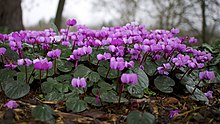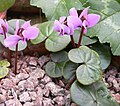|
Cyclamen coum
Cyclamen coum, the eastern sowbread,[1] is a species of flowering plant in the family Primulaceae. It is a tuberous herbaceous perennial, growing to 5–8 cm (2–3 in), with rounded heart-shaped leaves and pink shell-shaped flowers with darker coloration at the base. It is valued in horticulture as groundcover, and for the flowers which bloom in winter and early spring.[2] DescriptionThe tuber produces roots from the center of the bottom only.[3] It remains small, only reaching about 6.5 cm (2.6 in) across. The leaves are round or kidney-shaped to long heart-shaped. The color is all-silver, all-green, or silver variegated with a variably sized green hastate (arrowhead-shaped) or "Christmas tree" pattern and a green edge. The edge is smooth or gently toothed, but never angled and pointed as in Cyclamen hederifolium.[citation needed] The flowers are squat, with almost round petals, unlike any other group of cyclamen species. They bloom from winter to spring. The petals are magenta, pink, or white, with a darker blotch at the base. Below the blotch is a small white or pink "eye".[citation needed] EtymologyThe species name coum more likely refers to Koa or Quwê (an ancient region in eastern Cilicia, southeastern Turkey), which is part of the species' natural range, than to the island of Kos, where the species does not grow.[4] DistributionCyclamen coum is native to two areas. The main range is around the Black Sea, from Bulgaria through northern Turkey to the Caucasus and Crimea, and a disjunct population lies near the Mediterranean from the Hatay Province in Turkey through Lebanon to northern Israel.[citation needed] Cyclamen coum subsp. coum inhabits the western part of the main range and the southern area, while C. coum subsp. caucasicum inhabits the eastern part, including the Caucasus. Plants with intermediate characteristics are found in the middle of the range.[citation needed] CultivationCyclamen coum self-seeds and grows more slowly than Cyclamen hederifolium and is usually out-competed when the two are grown together. The species C. coum[5] and the form C. coum subsp. coum f. coum Pewter Group[6] have gained the Royal Horticultural Society's Award of Garden Merit (confirmed 2017).[7] HardinessAlong with C. hederifolium and C. purpurascens, C. coum is one of the hardiest cyclamen species, growing well in an area of New York where the temperature has reached as low as −19 °F (−28 °C). Subspecies and formsThere are two subspecies and three forms, distinguished by leaf and flower characteristics. Cyclamen elegans was formerly considered a subspecies (Cyclamen coum subsp. elegans), but is now a species in its own right.[citation needed]
Note: The isolate population of Crimea, formerly called Cyclamen kuznetzovii Kotov & Czernova, is now considered as a local variant of Cyclamen coum.[8][9] Gallery
Similar speciesThe Cyclamen coum group also includes Cyclamen abchasicum, Cyclamen elegans, Cyclamen alpinum, Cyclamen parviflorum and Cyclamen pseudibericum.
HybridCyclamen ×drydenii Grey-Wilson, a hybrid Cyclamen coum × Cyclamen alpinum, has intermediate characteristics, i.e., round leaves and horizontal twisted petals. References
External linksWikimedia Commons has media related to Cyclamen coum. Wikispecies has information related to Cyclamen coum.
|
||||||||||||||||||||||||||||||||
Portal di Ensiklopedia Dunia














